Pump Handbook by Igor J. Karassik, Joseph P. Messina, Paul Cooper, Charles C. Heald - 3rd edition
Подождите немного. Документ загружается.

9.260 CHAPTER NINE
of problems caused by the entrance of minute amounts of moisture into the brine at very
low temperatures.
Refrigerant Circulation For a number of reasons
—
including pressure and level con-
siderations as well as improvement of heat transfer
—
the refrigerant liquid is often cir-
culated with a pump. The centrifugal pump is usually preferred for this purpose.
The liquid being pumped as a refrigerant may be the same one that is pumped as a
brine.Whereas the material is all in liquid form throughout the brine circuit, some portion
of it is in vapor form during its circulation as a refrigerant. In a refrigerant circulating sys-
tem, most of the heat transfer is by evaporation, condensation, or both.
As there are changes from liquid to vapor, the liquid to be pumped must be saturated
in some portion or portions of the circuit. Sufficient NPSH for the pump must be provided
by the level of saturated liquid maintained in the tank where the liquid is collected. The
level difference required for the NPSH must provide adequate margin to compensate for
any temperature rise between the tank and the pump. This is an important consideration
because the liquid temperature will usually be considerably lower than that of the air sur-
rounding the pump intake pipe.
5
When the pump is not operating, it may be warm and may contain much refrigerant in
vapor form. It is usually necessary to provide a valved bypass from the pump discharge
back to the tank so gravity circulation can cool the pump and establish the prime.
Pumps for this service may require a double seal, with the space between the seals con-
taining circulated refrigerant oil at an appropriate pressure.This will reduce the possibil-
ity of the loss of relatively expensive refrigerant and eliminate the entrance of any air or
water vapor at pressures below atmospheric. A hermetic motor may also be used for this
service and thus avoid the use of seals.
Lubricating Oil Transfer Because the flow rates for lubricating oil transfer are rather
low, the gear pump is usually preferred. The NPSH requirement is also critical here
because, although the oil itself is well below the saturation temperature at the existing
pressure, it contains liquid refrigerant in equilibrium with the refrigerant gas. Any tem-
perature rise or pressure reduction will result in the separation of refrigerant vapor. It is
important, therefore, to design the path for oil flow from the level in the tank where it is
saturated with the same safeguards necessary for refrigerant pumping.
To reduce the oil pumping problem, the oil can be heated to a temperature above that
of the ambient air and vented to a low pressure in the refrigerant circuit. This eliminates
temperature rise in the pump as well as in the suction, with the corresponding reduction
of available NPSH.
Usually, the oil flow is intermittent, and the best results are obtained by continuous
pump operation discharging to a three-way solenoid valve. This discharge would be
bypassed back to the tank whenever transfer from the tank is not required. This assures
even temperature conditions and a pump free of vapor.
REFERENCES _______________________________________________________
1. Tested Solutions to Design Problems in Air Conditioning and Refrigeration, Industrial
Press, New York, Section 3.
2. Tested Solutions to Design Problems in Air Conditioning and Refrigeration, Industrial
Press, New York, Section 10.
3. Tested Solutions to Design Problems in Air Conditioning and Refrigeration, Industrial
Press, New York, Section 1, pp. 19
—
38; Section 4, pp. 63
—
65.
4. Tested Solutions to Design Problems in Air Conditioning and Refrigeration, Industrial
Press, New York, Section 9, pp. 119
—
125.
5. Tested Solutions to Design Problems in Air Conditioning and Refrigeration, Industrial
Press, New York, Section 2, pp. 44
—
47.

SIZE OF INSTALLATION _______________________________________________
In the typical steam-based utility, it is the function of pumped storage to (1) furnish peak-
ing capacity on the weekly load curve (Figure 1) and (2) generate full pumped storage in
an emergency for from 10 to 15 h, as required by the particular system. On the basis of
comparative cost estimates, the most economical size of installation is selected.
The principal features of a typical pumped storage project are shown schematically in
Figure 2.The overall efficiency is about 2:3; that is, 3 kW of pumping power will yield 2 kW
of peak generation. The economy of the process stems from the fact that dump energy for
pumping is worth about 3 mills/kW h, whereas peak energy is worth about 7 milli/kW
h. There is also an operating advantage. Because of the ease and rapidity with which it
may be placed on-line and because of its low maintenance charges, pumped storage is ide-
ally suited to peaking operation. On the other hand, for maximum economy, modern high-
pressure, high-temperature thermal plants should operate continuously near full load on
the base portion of the load curve.
Table 1 shows a typical calculation to determine the reservoir capacity needed for sus-
taining the weekly load curve. The reservoir capacity to carry full load for a 10- to 15-h
emergency is obtained simply by equating the electrical energy in kilowatt-hours in the
load to the potential hydraulic energy stored in the upper reservoir.
SELECTION OF UNITS ________________________________________________
At this stage of the basic engineering, it is necessary to make (in collaboration with the
equipment manufacturers) at least a tentative selection of capacity, diameter, speed, and
submergence for the turbomachine.This will be required for refinement of the calculations
GEORGE R. RICH
HOWARD A. MAYO, JR.
9.261
SECTION 9.13
PUMPED STORAGE
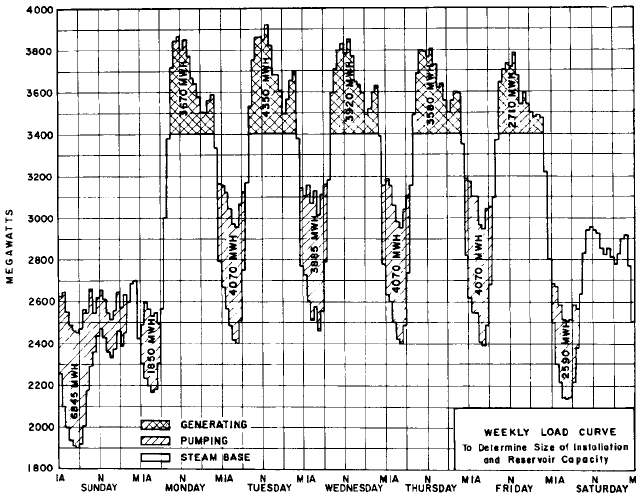
9.262 CHAPTER NINE
FIGURE 1 Weekly load curve
illustrated in Table 1 and also for the calculation of hydraulic transients that follows. In
the head range most attractive for overall project economy, 500 to 1500 ft (152 to 457 m),
manufacturers are prepared to offer a single turbomachine that is capable of operating as
a pump and whose direction of rotation is opposite that of a turbine. Electrical manufac-
turers offer a similar machine capable of operating as a synchronous motor for pumping
and, in the opposite direction of rotation, as a generator. These machines are designated
pump turbines and generator motors.
For best economy, the speed of the unit should be as high as is practicable without
involving an objectionable degree of cavitation of the impeller under the assumed sub-
mergence below minimum tailwater. This speed is established (1) by model tests for cavi-
tation at the hydraulic laboratories of the manufacturers and (2) by evaluating experience
with similar prototype installations.
Figure 3 is an experience chart showing specific speed N
s
1/2
/H
5/4
versus head
for the machine acting as a turbine, where H is total head), and Figure 4 shows the spe-
cific speed N
s
rpmQ
1/2
/H
3/4
for the machine acting as a pump. These charts presuppose
moderate values of submergence because unusually deep settings are uneconomical from
the structural standpoint. Three curves are fitted to the installations shown, the equation
of the curves being N
s
= K/H
1/2
. The depth of submergence may be verified by checking
against the value of the cavitation constant s (H
a
H
vp
H
s
)/H given by the manufac-
turer’s cavitation model test curves. Here H total head, H
vp
vapor pressure, s and H
a
atmospheric head. A typical curve of the family is shown in Figure 5.
When the unit has been selected, manufacturers will furnish (in advance of bid invita-
tions) prototype performance curves similar to Figures 6, 7, 8a, and 8b. Figures 8a and 8b
are designated four-quadrant synoptic charts and are required for the calculation of
hydraulic transients. Figure 8b is for a 5.59-in (142-mm) gate opening. This is the largest
gate opening at which the unit will be operating in the pumping cycle. Figure 8a, for an
rpm
#
hp
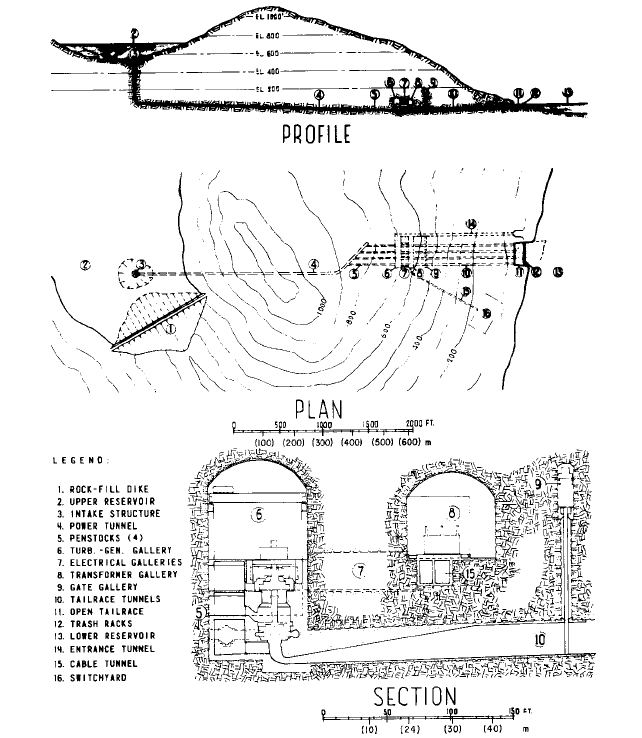
9.13 PUMPED STORAGE 9.263
FIGURE 2 Schematic arrangement for a pumped storage project. Elevations are in feet (1 ft = 0.3048 m).
8.94-in (227-mm) gate opening, is for operation on the turbine cycle only. Figure 9 shows a
schematic view of a pump-turbine with motor generator and starting motor.
HYDRAULIC TRANSIENTS _____________________________________________
In preparing purchase specifications for the generator motor, it is necessary to establish
the maximum transient speed and the moment of inertia of the rotor, WR
2
(GD
2
). Similarly,
for the pump turbine and penstock, it is necessary to determine the maximum water-
hammer. This primary calculation, as summarized in Figure 10 and Table 2, is made by
the trial-and-error method of arithmetic integration, using various trial values of WR
2
for
the condition of full-load rejection on all units during the generating mode with the tur-
bine gates assumed “stuck” in the full-gate position.

9.264 CHAPTER NINE
TABLE 1 Determination of reservoir capacity
(3) (4) (5)
Equivalent Net daily Cumulative
(1) (2) generation change in change in
Generating, Pumping, (col. 2 ), reservoir, reservoir,
MW MW h MW h MW h MW h Remarks
Monday PM 3670 3670 3670
Tuesday AM 4070 2710
PM 4350 1640 5310
Wednesday AM 3885 2585
PM 3920 1335 6645
Thursday AM 4070 2710
PM 3580 870 7515 Reservoir
empty
Friday AM 4070 2710
PM 2710 0 7515
Saturday 2590 1725 1725 5790
Sunday 6845 4560 4560 1230
Monday AM 1850 1230 1230 0 Reservoir
full
Required reservoir capacity to sustain weekly load curve:
Hours of capacity at full load and 900 ft (274 m) head:
Pertinent Data
Generating rated net head 900 ft (274 m)
Generating capacity at rated head for 3 units 525 MW
Pumping rated net head 930 ft (283 m)
Pumping power at rated head for 3 units 555 MW
Pumping-to-generating ratio 3 to 2
9600 62.4 43,560 0.746 900 0.85
525 1000 550 3600
;14.3 h
7515 1000 550 3600
62.4 43,560 0.746 900 0.85
9600 acre ft
2
3
Upon instantaneous loss of load, the unit builds up overspeed. The increase in speed
above normal causes a reduction in turbine discharge, which causes waterhammer, which
in turn further increases the power delivered to the rotor. This pyramiding continues until
the arrival of negative reflected water hammer from the upper reservoir. The head then
decreases. The unit is then so much over speed that it begins to act as a brake, as shown
by the four-quadrant synoptic chart (Figure 8). As shown by Figure 10 and Table 2, the
process gradually damps down to the steady-state runaway speed and head. Many addi-
tional and more refined calculations are made later in the course of the design to establish
the optimum governor time and rate of turbine gate closure, as given in detail in the works
listed at the end of this section.
STARTING THE UNIT__________________________________________________
The procedure for starting the unit is an essential feature of the design. There are three
cases to be considered: (1) the pumping mode, (2) the conventional generating mode, and
(3) rotating spinning reserve in the generating mode.
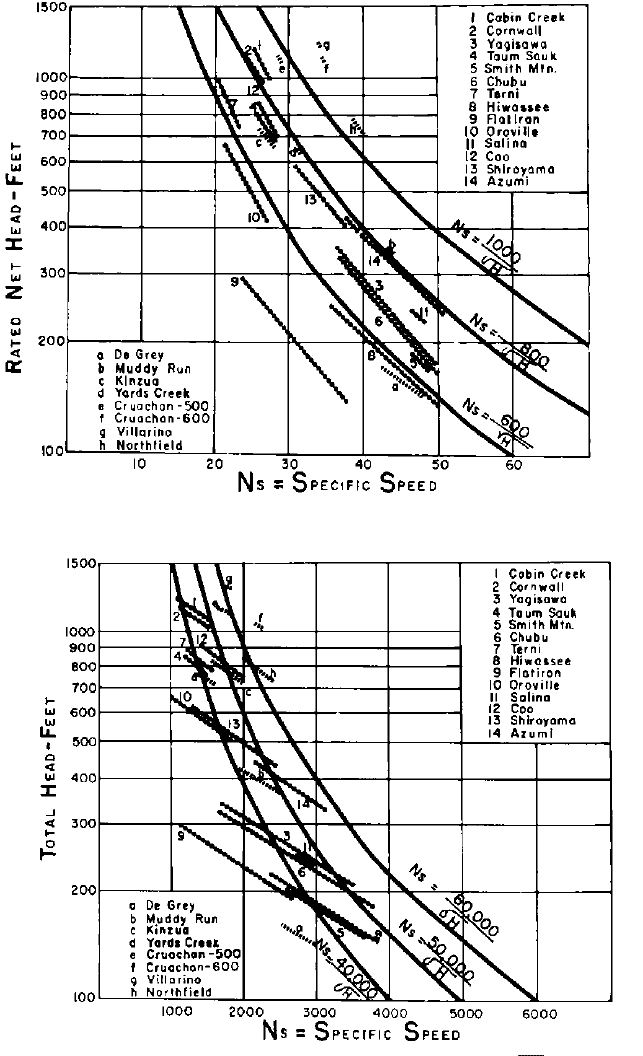
9.13 PUMPED STORAGE 9.265
FIGURE 3 Rated net head versus specific speed for a turbine (1 ft = 0.3048 m; N
s
= 0.2622(kW)
1/2
/ H
5/4
). See
Subsection 6.1.4 for the relation of N
s
to the universal specific speed
s
.
FIGURE 4 Total head versus specific speed for a pump (1 ft = 0.3048 m; N
s
= 51.65(rpm) = 2733
s
, where the universal specific speed
s
is defined in Chapter 1 and Section 2.1).
2m
3
>s>H
3>4
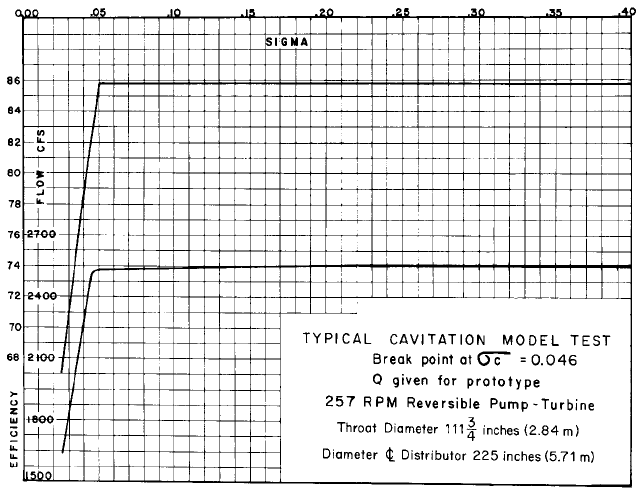
9.266 CHAPTER NINE
FIGURE 5 Typical cavitation model test (1 ft
3
/s = 0.0283 m
3
/s) (Voith Siemens Hydro)
Pumping Mode If we attempted to start the unit as a pump, from rest and with the
spiral case and draft tube filled, the power and inrush current would be excessive. Accord-
ingly, the standard type of compressed air system is provided to depress the tailwater ele-
vation to below the bottom of the impeller, with the wicket gates closed. The load to be
overcome at starting then consists of the load of the rotating masses, which must be accel-
erated to synchronous speed, and the load due to windage. Owing to inevitable leakage
past the wicket gates, this windage is substantially greater than that due to dry air. The
main penstock valves must also be closed during starting, or else the leakage and “wet”
windage would be still further increased at the much higher head.
For the larger units generally employed, a separate starting motor, of the induction
type with wound rotor, is mounted directly above the main generator motor. It has not
been found feasible, in the motor space available, to design an amortisseur winding capa-
ble of sustaining the heat from the inrush current resulting from across-the-line starting
of the main generator motor, even at reduced voltage. For the smaller units, however, this
may be accomplished. In rare instances, where a main unit is always available, this spare
may be electrically coupled to the pumping unit and the two started from rest in back-to-
back synchronism. The separate starting motor is usually sized to bring the main unit up
to synchronous speed in about 10 minutes, as shown by Figure 11.
When the unit has attained full speed, it is synchronized to the line, the compressed air
is cut off, the tailwater rises to fill the draft tube, the wicket gates and main penstock valve
are opened gradually to prevent shock, and pumping to the upper reservoir begins.
The maximum transient load on the generator motor thrust bearing occurs just as
pumping begins. Prior to the advent of pumped storage, thrust bearings were designed to
carry the weight of the rotating parts plus the hydraulic thrust at the steady-state condi-
tion. Now a greatly increased thrust of short duration must also be accommodated.
Because of the short duration of this transient excess load, it may usually be carried safely
by the bearing as designed for the steady-state requirement, depending on the detailed
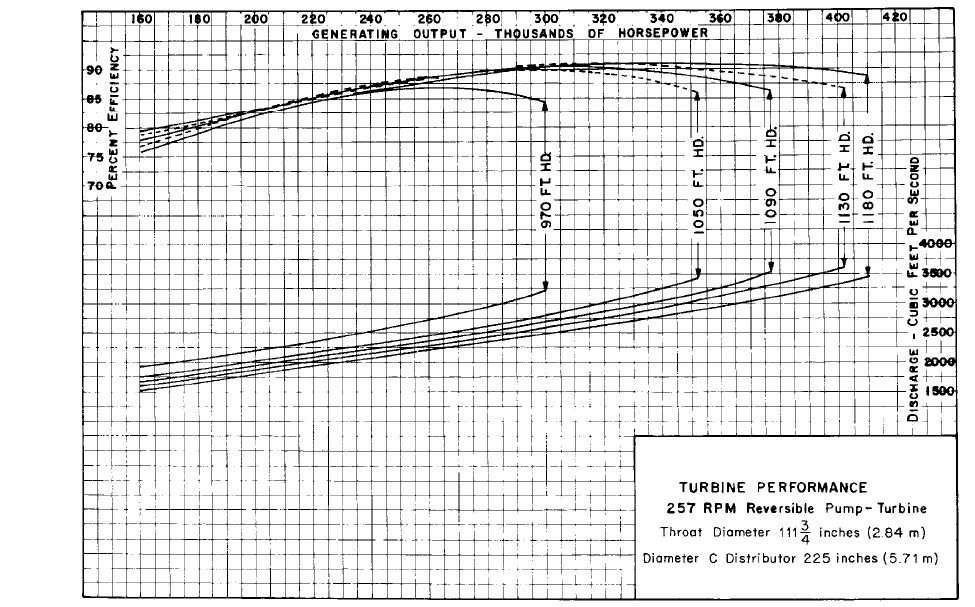
9.267
FIGURE 6 Turbine performance (1 ft
3
/s 0.0283 m
3
/s; 1 ft = 0.3048 m; 1 hp 0.746 kW) (Voith Siemens Hydro)
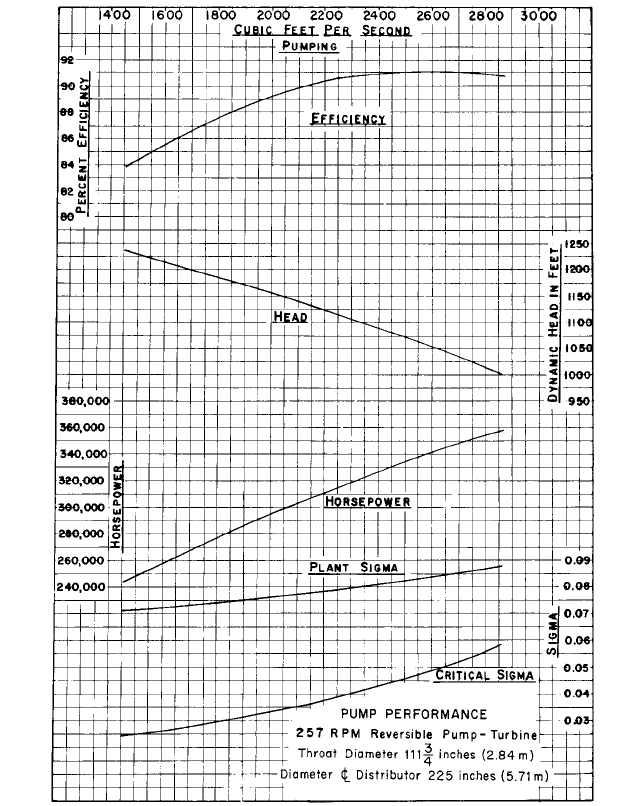
9.268 CHAPTER NINE
FIGURE 7 Pump performance (1 hp = 0.746 kW; 1 ft = 0.3048 m; 1 ft
3
/s = 0.0283 m
3
/s) (Voith Siemens Hydro)
design of the bearing. It is now standard practice to provide a high-pressure oil pumping
system to ensure that there will be a film of oil between the bearing surfaces before the
unit starts rotating.
Conventional Generation For generation in the conventional manner, the unit may be
started from rest under its own power without assistance from the starting motor.
Rotating Spinning Reserve In considering the requirements for starting the unit for
rotating spinning reserve, it will be assumed that the utility is a participant in a grid sys-
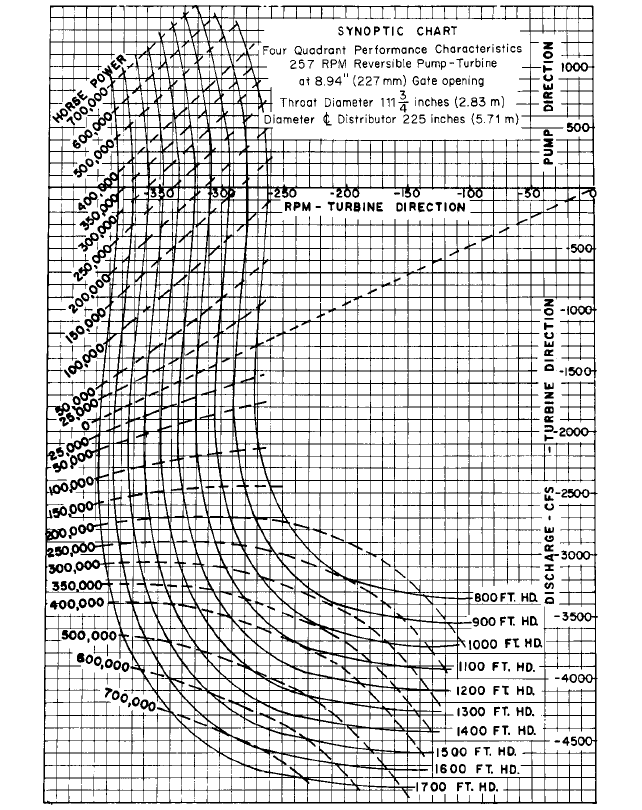
9.13 PUMPED STORAGE 9.269
tem of interconnection by means of extra-high-voltage (EHV) transmission lines of high
capability. This means that, immediately upon loss of generation by the local utility, the
EHV connection will carry the necessary load for the short time required (about 30 s) for
the local pumped storage units to absorb full load. In readiness for just such an emergency,
these local pump turbines will be motoring on the line in the generating direction, with
the wicket gates and main penstock valves closed and with the tailwater depressed. The
loads and procedure for bringing the units up to speed for synchronizing to the line for
rotating spinning reserve are identical with those given for operation in the pumping
mode except that rotation is in the generating direction.
FIGURE 8A Synoptic chart for an 8.94-in (227-mm) opening (1 hp = 0.746 kW; 1 ft = 0.3048m; 1 ft
3
/s
= 0.0283 m
3
/s) (Voith Siemens Hydro)
